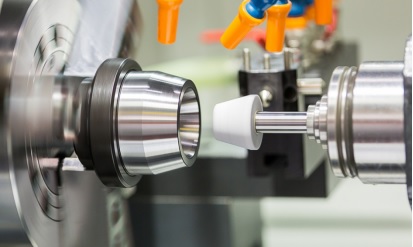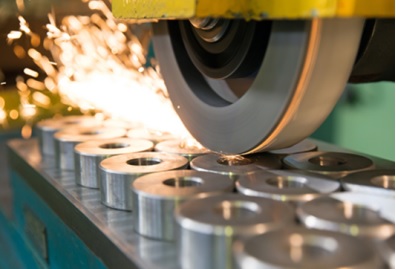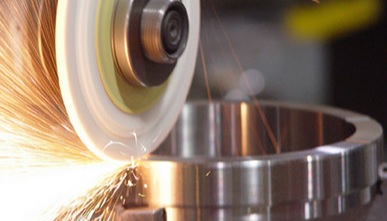How to Perform Mirror Grinding?
01 What is mirror grinding?
After grinding, the surface roughness of the workpiece is less than 0.01µm (Ra<0.01µm). It is as mirror-like and can be imaged clearly. Therefore, it is called mirror grinding. The flatness of the grinding plane is not more than 3µm/1000mm. The surface processing of high-precision, high-value-added parts usually requires mirror grinding.

02 The grinder for mirror grinding must have the following conditions
1) It has high accuracy and rigidity, and adopts vibration reduction measures.
2) The rotation accuracy of the grinding wheel spindle is higher than 1 µm.
3) The amplitude of the grinding wheel carriage relative to the worktable is less than 1 µm.
4) The transverse feed mechanism can accurately move slightly.
5) There is no crawling phenomenon when the workbench moves at low speed.
03 Method for mirror grinding
1. Balancing and dressing the grinding wheel
(1) Balance grinding wheel. After the flange is installed on the grinding wheel, the rough static balance is performed first, then the two end faces and outer circle are trimmed on the grinding wheel shaft, and finally the precise static balance is performed.
(2) Dressing the grinding wheel. The quality of the grinding wheel dressing directly affects the smoothness of the grinding surface. In order to reduce the surface roughness value, dressing the grinding wheel is the key. Pay attention to the following matters when dressing the grinding wheel:
1) The general fine grinding allowance is 0.015~0.02mm. When the workpiece is coarsely ground to Ra0.8, the fine grinding allowance is 0.005~0.015mm (the remaining grinding allowance must be determined according to the nature and hardness of the steel. The steel with high hardness and easy to be polished should have less grinding allowance), then the grinding wheel needs to be refined.
2) When finishing the grinding wheel, first remove the thickness of about 0.1mm, then trim it twice with a depth of cut of 0.02mm, and trim three times with a depth of cut of 0.01mm, and finally reciprocate twice without the depth of cut. During finishing, the transverse feed speed is 20~30mm/min. For mild steel workpieces, it is better to slow the lateral feed when grinding the grinding wheel, and the opposite is true when processing hardened high-speed steel.
3) While dressing the grinding wheel, sufficient grinding fluid or other cooling fluid must be used to flush the contact point between the grinding wheel and the diamond knife to flush away the grinding wheel debris in time to avoid affecting the grinding quality.
4) The diamond knife used in finishing does not need to be very sharp, because the grain size of the grinding wheel is relatively coarse. The diameter of the diamond tip can be within 0.8mm. When trimming with a sharp diamond knife, the traverse feed speed must be slowed down.
6) When the newly-dressed grinding wheel is used, the surface roughness is slightly worse, and it will stabilize after a while.

2. Grinding amount
1) The amount of knife on the back of the grinding wheel is about 0.005 mm. Appropriate increase or decrease according to the nature and hardness of the workpiece steel. For example, hardened steel with high hardness can easily cause burns if the knife is too large, while the amount of soft steel is too small to be polished.
2) The single stroke of the horizontal feed is 0.2~0.4mm. The speed of the lateral feed has a greater influence on the surface roughness, because the grinding wheel for mirror grinding has poor cutting ability. If the lateral feed speed increases, the surface of the grinding wheel will be damaged, so a very smooth surface cannot be obtained.
3) The longitudinal feed rate is 12~15 m/min. The longitudinal feed has a relatively small effect on the surface roughness, but if it is too slow, the surface of the workpiece will produce ripples or patterns.
4) No-cut deep polishing. Due to the poor cutting ability of the grinding wheel during mirror grinding, tool marks often appear on the surface of the workpiece (round workpieces are moon-shaped, rectangular workpieces are band-shaped), which reflect that the surface of the workpiece is not straight, so no-feed smooth grinding is required About two minutes.

04 Defects easy to produce during mirror grinding and measures
Mirror grinding on a surface grinder often produces some defects, such as surface ripples, burns, scratches, obvious patterns and wear marks (silk flow), etc. To address these problems, the following measures can be taken:
1) The surface ripples are mostly caused by the vibration of the grinding wheel, such as excessive bearing clearance, deviation of the spindle, poor dynamic balance of the motor rotor, uneven oil film between the spindle and the bearing, etc. In addition, if the grinding wheel is not well balanced, it will produce ripples. If the grinding wheel is well balanced and there are still ripples, then the grinding wheel and its mating parts must be repaired or adjusted to completely eliminate the ripples.
2) When machining materials with high hardness, the grinding efficiency of the grinding wheel is poor, and the grinding point will generate high temperature, which is easy to burn the workpiece. For example, when grinding W18Cr4V, it is more likely to produce burns. In order to prevent burns, there must be sufficient grinding fluid at the grinding point. In addition, the amount of knives should be appropriate, not too large. The best way is to reduce the linear speed of the grinding wheel, about 18m/s is appropriate. Using a low speed of 1440r/min on the M7120A grinder can basically eliminate burns. Another advantage of reducing the linear speed of the grinding wheel is to reduce the vibration of the grinding wheel holder, which can also reduce and eliminate the ripple phenomenon.
3) There are roughly two types of scratches in mirror grinding: one type of scratches is irregular, which is caused by impure grinding fluid, impurities and abrasive particles that are washed between the grinding wheel and the workpiece. The method to eliminate this kind of scratches requires the grinding fluid to be filtered, generally using magnetic and copper wire mesh three-pass filtration; the other kind of scratches are like dotted lines, shallower, and the length is about the same. This is a grinding wheel. When the grain is about to fall off, it will be scratched as the grinding wheel rotates. At this time, the elimination method is to use sufficient grinding fluid when dressing the grinding wheel, and trim the two end faces of the grinding wheel into an oblique shape with outer width and inner width. In addition, the selection of the grinding wheel should be appropriate, not too soft, and do not use a grinding wheel with too good self-sharpening properties.
4) When mirror grinding, there are many forms of patterns that are easy to appear. There are also many factors that produce patterns. The main reason is vibration. Among them, there are periodic vibrations of the grinding wheel, external influences and vibrations of adjacent machine tools, etc., and patterns will also appear when the grinding wheel is too blunt and the stroke is unstable. When the adjacent machine tool is not running, the pattern will not appear easily.
5) When the wear scar (silk flow) in mirror grinding is more obvious, to remove this kind of wire flow, you must switch to a fine-grained grinding wheel. However, when using fine-grained grinding wheels, the following points must be considered:
①When finishing the grinding wheel, the diamond knife should be sharp, and the grinding fluid should be sufficient to wash away the debris in time to avoid affecting the surface of the grinding wheel.
②The amount of grinding should be appropriate to prevent surface burns and other defects that affect the surface finish. Pay attention to leave an appropriate grinding allowance.
③The linear speed of the grinding wheel must be reduced to 15~18m/s.
④ The grinding fluid is strictly filtered to prevent scratches.
⑤ When using a grinding stone to fine-tune the grinding wheel, the contact area between the grinding stone and the grinding wheel should not be too small, and the grinding stone used should not be too soft, otherwise it will not play the role of the grinding wheel.


